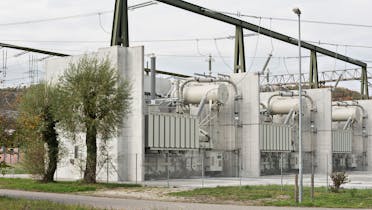
We often see extra-high-voltage power lines while out for a walk. And maybe we have even asked ourselves: where do they lead? Sometimes we might notice a large electrical system, a complex tangle of conductor cables and insulators. Is energy generated there? No, as some well-informed people already know. What we see there is switchgear. But the question is, if the system is not used for power generation, what is it for? And why do all these power lines lead to it?
In the new brochure “Substations and Transformers – Important Elements in the Transmission Grid”, we describe the role of switchgear and transformers in the transmission grid in simplified terms, using a lot of pictures and graphics to give you an even clearer understanding. The illustrations are true to scale so that the substation elements are shown as realistically as possible. With the help of this brochure, Swissgrid provides further insight into the complex world of electricity.
Let’s look at some examples:
AIS and GIS
No, these are not abbreviations for insurance companies. AIS stands for air-insulated switchgear, while GIS stands for gas-insulated switchgear. What’s the difference? The first is a large open-air device in which air acts as an insulator, whereas the second is a device inside a case insulated with gas. Gas-insulated switchgear takes up much less space than air-insulated switchgear.
Transformers – the heart of the grid
Before we can use electricity in everyday life, its voltage must be converted from 380/220 kV (Swissgrid grid) to the regional and local voltage (distribution grids) of 230 V. The electricity grid can be compared to a road system: Swissgrid’s grid is the electricity highway, while the regional and local distribution systems are the cantonal and municipal roads. Energy is transported over long distances and in large quantities at extra-high voltage (220 and 380 kV), thus reducing losses. The voltage is continuously lowered in transformers at the different grid levels so that we can use 230 V electricity in our homes.
Switchgear
The switchgear housed in substations function as nodes between the various lines. In addition, the Swissgrid grid control rooms disconnect and connect lines in the switchgear by means of switching operations, thereby controlling energy flows.
In the switchgear, a distinction is made between primary elements (generators, technical equipment, busbars and electrical components) and secondary technology (protection and communication systems).
As simple as it may seem to switch on a light, the electrical system behind it is extremely sophisticated. A sophisticated system brings electricity from power plants right into our homes via electricity grids, transformers and substations.






